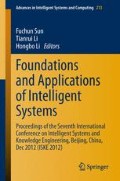Abstract
In this paper, we consider a cognitive radio system with multiple cognitive radio (CR) links in the same neighborhood and propose an opportunistic power control strategy for the CR links. The key feature of the proposed strategy is that, via opportunistically adjusting the CR links’ transmit power, the cognitive user can maximize its achievable transmission rate without degrading the outage probability of the primary user. Since it is difficult to track channel gains instantaneously for dynamic cognitive radio network in practice, the case where only mean channel gains averaged over short-term fading are available is considered. Under such scenarios, we derive interference constraints violation probabilities for primary user so that the interference constraints are only violated with desired limit. The achievable sum rate of the CR links under the proposed power control strategy is analyzed and simulated, taking into the impact of imperfect channel estimation. The robustness of the network system is improved with the proposed scheme.
Access this chapter
Tax calculation will be finalised at checkout
Purchases are for personal use only
References
FCC (2002) FCC spectrum policy task force report. ET-Docket 20–135, November. FCC, Washington, DCJ. In: Maxwell C (ed) A treatise on electricity and magnetism, 3rd ed, vol 2. Clarendon, Oxford, 1892, pp 68–73
Mitola J III, Maguire GQ (Aug 1999) Cognitive radios: making software radios more personal. IEEE Personal Commun 6(4):13–18
Haykin S (Feb 2005) Cognitive radio: brain-empowered wireless communications. IEEE J Select Areas Commun 23(2):201–202
Brodersen RW, Wolisz A, Cabric D et al (2004) Corvus: a cognitive radio approach for usage of virtual unlicensed spectrum. UC Berkeley White Paper, July
Horne WD Adaptive spectrum access: using the full spectrum space. In: Proceedings of the 31st annual telecommunication policy research conference. Available http://tprc.org
Srinivasa S, Jafar SA (2007) The throughput potential of cognitive radio: a theoretical perspective. IEEE Commun Mag 45(5):2637–2642
Zhang L, Liang YC, Xin Y (Jan 2008) Joint beamforming and power allocation for multiple access channels in cognitive radio networks. IEEE J Select Areas Commun 26(1):38–51
Jovicic A, Viswanath P (2006) Cognitive radio: an information-theoretic perspective. IEEE Trans Inform Theor
Ghasemi A, Sousa ES (Feb 2007) Fundamental limits of spectrum-sharing in fading environments. IEEE Trans Wirel Commun 6(2):649–658
Wang W, Peng T, Wang W (2007) Optimal power control under interference temperature constraints in cognitive radio network. In: Proceedings of the IEEE, wireless communications and networking conference (WCNC’07), pp 116–120, March 2007
Hamdi K, Zhang W, Letaief KB (2007) Power control in cognitive radio systems based on spectrum sensing side information. In: Proceedings of the IEEE international conference on, communications (ICC’07), pp. 5161–5165, June 2007
Kim DI, Le DI, Hossain E (Dec 2008) Joint rate and power allocation for cognitive radios in dynamic spectrum access environment. IEEE Trans Wirel Commun 7:5517–5527
This work was supported partially by the NSFC under Grant 61104033 and 61174127; the NSFC key Grant with No. 60934003; and the Hebei Provincial Natural Science Fund under Grand F2012203109 and F2012203126. The work of Hongjiu Yang was supported by the National Natural Science Foundation of China under Grant 61203023 and the Postdoctoral Science Foundation of China under Grant 2012M510769, respectively.
Author information
Authors and Affiliations
Corresponding author
Editor information
Editors and Affiliations
Rights and permissions
Copyright information
© 2014 Springer-Verlag Berlin Heidelberg
About this paper
Cite this paper
Liu, Z., Wang, J., Yang, H., Ma, K. (2014). Joint Rate and Power Allocation for Cognitive Radios Networks with Uncertain Channel Gains. In: Sun, F., Li, T., Li, H. (eds) Foundations and Applications of Intelligent Systems. Advances in Intelligent Systems and Computing, vol 213. Springer, Berlin, Heidelberg. https://doi.org/10.1007/978-3-642-37829-4_26
Download citation
DOI: https://doi.org/10.1007/978-3-642-37829-4_26
Published:
Publisher Name: Springer, Berlin, Heidelberg
Print ISBN: 978-3-642-37828-7
Online ISBN: 978-3-642-37829-4
eBook Packages: EngineeringEngineering (R0)

